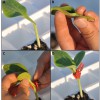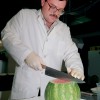Grafting as a cultural practice for controlling soilborne diseases and improving abiotic stress tolerance has been widely used in vegetable production in many areas of Asia and Europe. Interest in vegetable grafting has been growing in the United States in recent years, as well. Cost, along with the desire to customize scion cultivars and the need to produce organic transplants, has led many small and organic growers to choose to graft plants by themselves. To help growers who are interested in grafting melon plants achieve a high graft survival rate, this 5-page fact sheet introduces commonly used grafting techniques and their application in specific circumstances. Written by Wenjing Guan and Xin Zhao, and published by the UF Department of Horticultural Sciences, December 2014.
 fl.edu/hs1257>http://edis.ifas.ufl.edu/hs1257
fl.edu/hs1257>http://edis.ifas.ufl.edu/hs1257
Tag: Melons
Outbreaks of Foodborne Illness Associated with Melons
 Despite the manner in which they are prepared, melons are commonly consumed raw without a processing step which would eliminate pathogenic bacteria. For those concerned about the safety of melons, including cantaloupe, honeydew, and watermelon, this 6-page fact sheet lists outbreaks associated with melons in the United States, Canada, and Europe, along with information about the location, pathogen, and incidence of illness. Written by Michelle D. Danyluk, Rachel McEgan, Ashley N. Turner, and Keith R. Schneider, and published by the UF Department of Food Science and Human Nutrition, November 2014. (UF/IFAS Photo by Thomas Wright)
Despite the manner in which they are prepared, melons are commonly consumed raw without a processing step which would eliminate pathogenic bacteria. For those concerned about the safety of melons, including cantaloupe, honeydew, and watermelon, this 6-page fact sheet lists outbreaks associated with melons in the United States, Canada, and Europe, along with information about the location, pathogen, and incidence of illness. Written by Michelle D. Danyluk, Rachel McEgan, Ashley N. Turner, and Keith R. Schneider, and published by the UF Department of Food Science and Human Nutrition, November 2014. (UF/IFAS Photo by Thomas Wright)
http://edis.ifas.ufl.edu/fs258